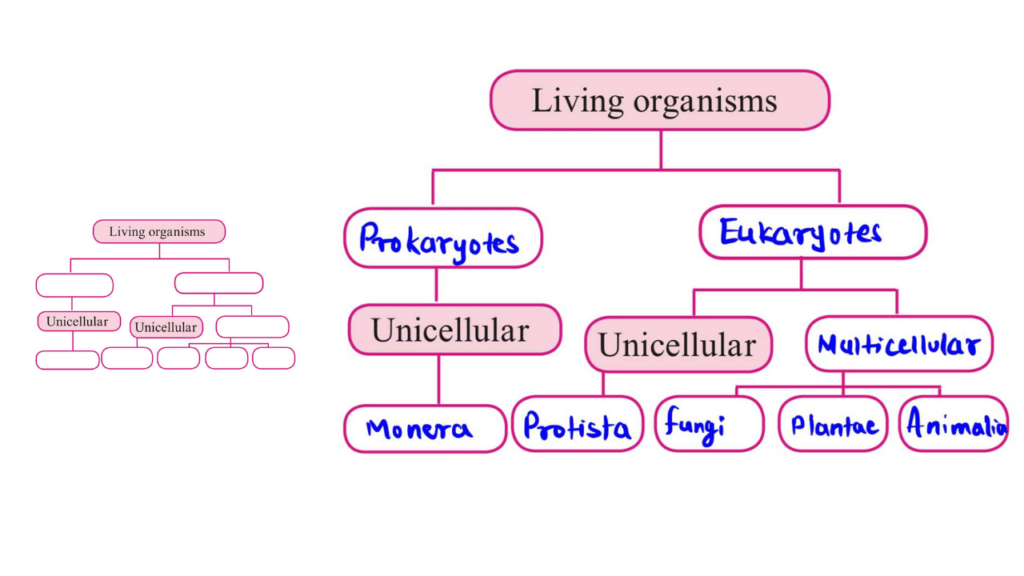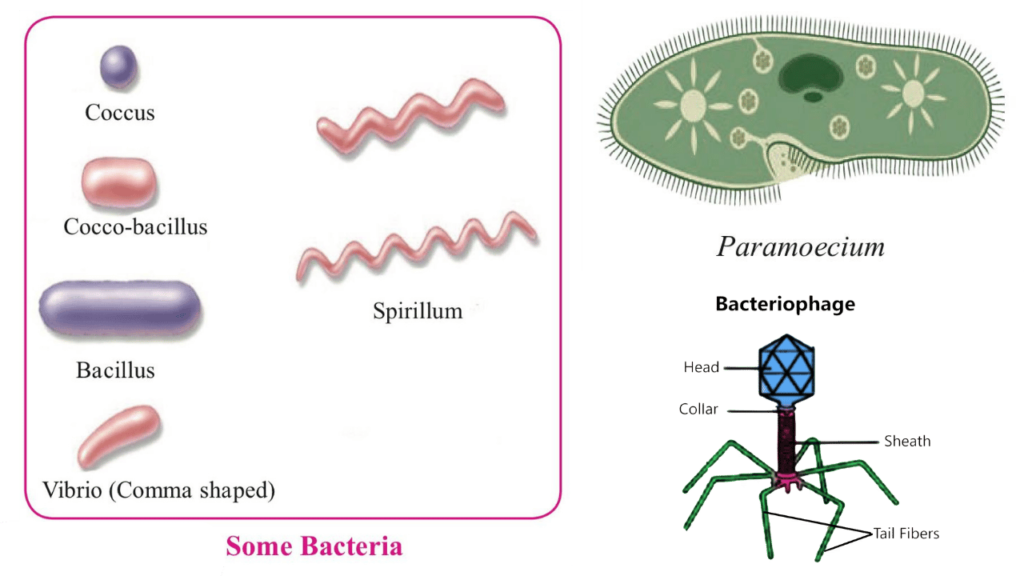
1. Use the Whittaker method to classify bacteria, protozoa, fungi, algae, prokaryotic, and eukaryotic, microbes.
Answer:
- Bacteria: Kingdom Monera
- Protozoa: Kingdom Protista
- Fungi: Kingdom Fungi
- Algae: If unicellular, Kingdom Protista. If multicellular, Kingdom Plantae
- Prokaryotic: Kingdom Monera
- Eukaryotic: Any kingdom other than Monera.
- Microbes: Kingdom Monera or Protista.
2. Complete the five kingdom method of classification using living organisms, prokaryotes, eukaryotes, multicellular, unicellular, Protista, animals, plants, and fungi.

3. Find out my partner
| A | B |
| Fungi | Chlorella |
| Protozoa | Bacteriophage |
| Virus | Candida |
| Algae | Amoeba |
| Bacteria | Prokaryotic |
Answer
| A | B |
| Fungi | Candida |
| Protozoa | Amoeba |
| Virus | Bacteriophage |
| Algae | Chlorella |
| Bacteria | Prokaryotic |

4. State whether the following statements are True or False. Explain your statement:
a. Lactobacilli are harmful bacteria.
Answer: False,
Explanation Lactobacilli are useful bacteria. They are used for curdling the milk. They are also used for preparing a variety of milk products.
b. The cell wall of fungi is made up of chitin.
Answer: True,
Explanation The plant cell wall is composed of cellulose while the cell wall of fungi is made up of complex sugar called chitin. Inside the fungal cell wall, there is cytoplasm which contains many nuclei.
c. Organ of locomotion in amoeba is pseudopodia.
Answer: True,
Explanation Amoeba is a protozoan, a primitive organism which possesses pseudopodia as the organ for locomotion.
d. Tomato wilt is a viral disease.
Answer: True,
Explanation: Tomato wilt is a viral disease. These viruses can infect only plant cells.
5. Give answers
a. State the merits of Whittaker’s method of classification.
Answer:
- Unicellular and multicellular organisms are kept under separate categories.
- Autotrophs and heterotrophs are placed in separate groups
- A separate fungus was assigned to fungi because of its mode of nutrition
- It is more natural than the two-kingdom classification
- Prokaryotes are placed under a separate category of Monera.
b. Write the characteristics of viruses.
Answer:
1. Viruses are extremely minute in the size range of 10 nrn to 100 nm. They are on the borderline of living and non-living. They are 10 to 100 times smaller than bacteria and are visible only through the electron microscope.
2. Though they are not considered living, they can make replicas of their own.
3. They exist in the form of independent particles. They are long molecules of DNA or RNA covered by a protein coat.
4. Their survival is possible only inside the living plant or animal cells. When they infect the host cells, they produce their own proteins with the host cell’s machinery. These proteins form many replicas of the infecting virus.
5. This infection destroys the host cell and the virus replicas are released. These free replicas re-infect the other adjoining cells of the host.
6. Most viruses are pathogenic, they cause diseases in plants and animals.
c. Explain the nutrition in fungi.
Answer:
Most of the fungi are saprophytic in their nutrition. They absorb the nourishment from dead and decaying matter. By taking the organic matter from the dead bodies of plants and animals, fungi survive. In this process, they degrade the organic matter completely.
d. Which living organisms are included in the kingdom Monera?
Answer:
- All the living organisms belonging to Kingdom Monera are unicellular.
- The mode of nutrition in them is either autotrophic or heterotrophic.
- All of them are prokaryotic and thus they do not have a well-formed nucleus. The nuclear membrane and the cell organelles are absent in them.
- Kingdom Monera consists of different types of bacteria and blue-green algae.
E.g. Bacteria Clostridium titani, Vibrio choleri, Treponema pallidum, Streptococcus pneumoniae, Legionella pneumoniae, Salmonella typhi, Staphylococcus aureus, Clostridium botulinum.

6. Who am I?
a. I don’t have a true nucleus, cell organelles or plasma membrane.
Answer: Microbe from Monera
b. I have a nucleus and membrane-bound cell organelles.
Answer: Protozoan from Protista/I am any one of Eukaryote
c. I live on decaying organic matter.
Answer: Fungus
d. I reproduce mainly by cell division. (*Binary fission)
Answer: Bacteria and some Protozoa.
e. I can produce my replica.
Answer: Virus
f. I am green but don’t have organs.
Answer: Algae
7. Draw neat and labelled diagrams.
a. Different types of bacteria
b. Paramoecium
c. Bacteriophage.

8. Arrange the following in ascending order of size Bacteria, Fungi, Viruses, and Algae.
Answer: Viruses, Bacteria, Fungi, Algae.


